2A M3U3 In the kitchen(课时教案)牛津上海版(试用本)
- 格式:docx
- 大小:10.55 KB
- 文档页数:3
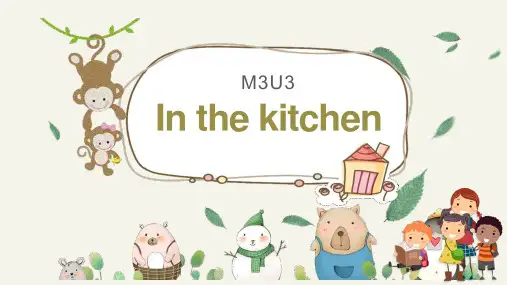
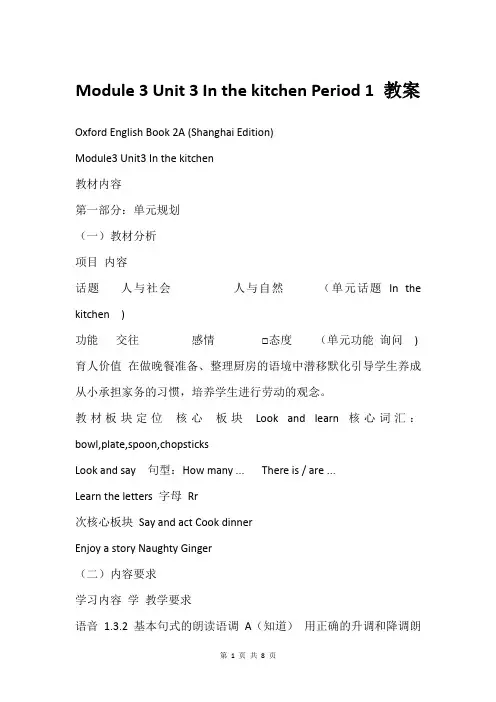
Module 3 Unit 3 In the kitchen Period 1 教案Oxford English Book 2A (Shanghai Edition)Module3 Unit3 In the kitchen教材内容第一部分:单元规划(一)教材分析项目内容话题人与社会人与自然(单元话题In the kitchen )功能交往感情□态度(单元功能询问)育人价值在做晚餐准备、整理厨房的语境中潜移默化引导学生养成从小承担家务的习惯,培养学生进行劳动的观念。
教材板块定位核心板块Look and learn 核心词汇:bowl,plate,spoon,chopsticksLook and say 句型:How many ... There is / are ...Learn the letters 字母Rr次核心板块Say and act Cook dinnerEnjoy a story Naughty Ginger(二)内容要求学习内容学教学要求语音1.3.2 基本句式的朗读语调A(知道)用正确的升调和降调朗读基本句式词汇2.1 核心词汇C(运用)理解和运用核心词汇句法 4.2.2.2 特殊疑问句C(运用)用特殊疑问句提问,并作出回答语篇5.1.1 记叙文基本信息A(知道)简单讲述对话、故事等记叙文中的时间、地点、人物、事件等基本信息(三)学情分析内容知识要点教材栏目学生基础活动选择语音陈述句的朗读语调特殊疑问句的朗读语调Say and act Look and say 熟知略知新知倾听、模仿、跟读、朗读...词汇餐具类词汇:bowl,plate,spoon,chopsticks Look and learn Look and say Say and act 熟知略知新知倾听、模仿、跟读、朗读...句法句型:How many ... There is / are ... Look and say Enjoy a story 熟知□ 略知新知倾听、模仿、朗读、问答...第二部分:单元整体设计主题与话题单元教学目标与单元语用任务【单元教学目标】知识与技能能在语境中感知朗读陈述句和特殊疑问句的正确语调。
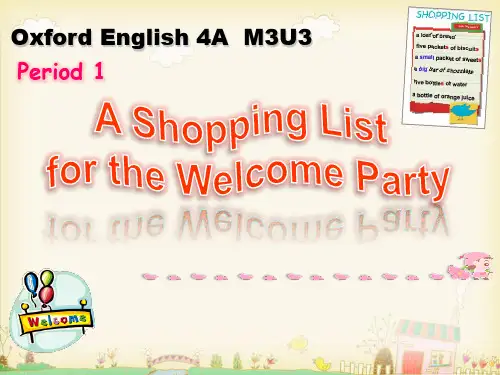
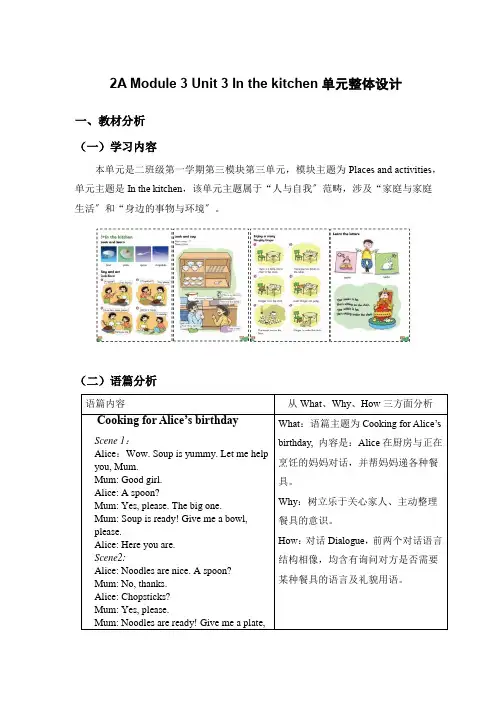
2A Module 3 Unit 3 In the kitchen单元整体设计一、教材分析(一)学习内容本单元是二班级第一学期第三模块第三单元,模块主题为Places and activities,单元主题是In the kitchen,该单元主题属于“人与自我〞范畴,涉及“家庭与家庭生活〞和“身边的事物与环境〞。
(二)语篇分析(三)教学内容分析二、学情分析二班级同学已在此前学习过与食物有关的词汇,会用简洁的形容词描述食物;已学习仿照运用核心句型How many…?询问物品的数量;已学习仿照运用核心句型Give me a…Here you are. Thank you.懂得根本的社交礼仪与日常问答。
以下是学情分析表:三、教学目标 〔一〕单元目标● 学问与技能1. 能知晓、背记字母 Qq, Rr 的音、形及其在单词中的根本读音,并能正确书写;能朗读含有字母 Qq, Rr 的相关单词和儿歌。
能用降调朗读特别疑问句How many…?和陈述句 There is/are...。
2. 能在语境中听、读关于厨房餐具类单词 bowl, plate, spoon, chopsticks ,并能说出这些餐具的名称,知晓他们的复数形式。
3. 能在语境中仿照运用核心句型How many…?询问物品的数量,并做出应答。
能用There is/are...对物品的数量和位置进行描述。
4. 能在语境中听懂、读懂 Look and say, Say and act, Enjoy a story 等教材板块中的对话和故事的意思,猎取相关根本信息,并能尝试进行对话和故事表演。
● 思维与策略在课堂学习和沟通中仔细倾听,乐于仿照,乐观思索,并尝试运用所学语言学问进行表达和沟通。
● 文化与情感树立在家长烹饪时乐于关心、主动整理餐具的意识,同时,初步感受餐具文化,了解根本的餐桌礼仪。
● 单元语用任务在“In the kitchen 〞的相关语境中,能询问及答复所需的餐具、询问及答复餐具的数量,及描述餐具所在的位置。
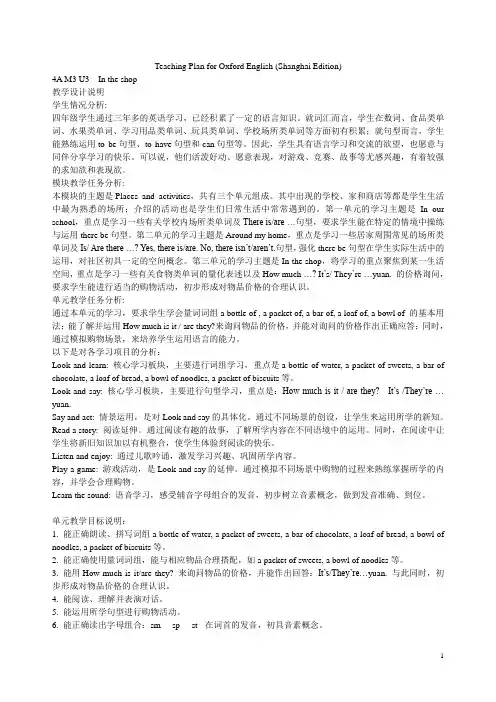
Teaching Plan for Oxford English (Shanghai Edition)4A M3 U3 In the shop教学设计说明学生情况分析:四年级学生通过三年多的英语学习,已经积累了一定的语言知识。
就词汇而言,学生在数词、食品类单词、水果类单词、学习用品类单词、玩具类单词、学校场所类单词等方面初有积累;就句型而言,学生能熟练运用to be句型、to have句型和can句型等。
因此,学生具有语言学习和交流的欲望,也愿意与同伴分享学习的快乐。
可以说,他们活泼好动、愿意表现,对游戏、竞赛、故事等尤感兴趣,有着较强的求知欲和表现欲。
模块教学任务分析:本模块的主题是Places and activities,共有三个单元组成。
其中出现的学校、家和商店等都是学生生活中最为熟悉的场所;介绍的活动也是学生们日常生活中常常遇到的。
第一单元的学习主题是In our school,重点是学习一些有关学校内场所类单词及There is/are …句型,要求学生能在特定的情境中操练与运用there be句型。
第二单元的学习主题是Around my home,重点是学习一些居家周围常见的场所类单词及Is/ Are there …? Yes, there is/are. No, there isn’t/aren’t.句型,强化there be句型在学生实际生活中的运用,对社区初具一定的空间概念。
第三单元的学习主题是In the shop,将学习的重点聚焦到某一生活空间,重点是学习一些有关食物类单词的量化表述以及How much …? It’s/ They’re …yuan. 的价格询问,要求学生能进行适当的购物活动,初步形成对物品价格的合理认识。
单元教学任务分析:通过本单元的学习,要求学生学会量词词组a bottle of , a packet of, a bar of, a loaf of, a bowl of 的基本用法;能了解并运用How much is it / are they?来询问物品的价格,并能对询问的价格作出正确应答;同时,通过模拟购物场景,来培养学生运用语言的能力。
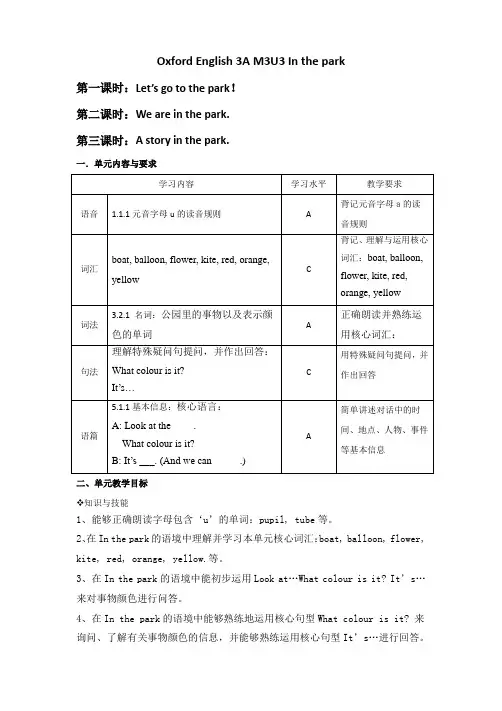
Oxford English 3A M3U3 In the park第一课时:Let’s go to the park!第二课时:We are in the park.第三课时:A story in the park.一.单元内容与要求二、单元教学目标❖知识与技能1、能够正确朗读字母包含‘u’的单词:pupil, tube等。
2、在In the park的语境中理解并学习本单元核心词汇:boat, balloon, flower, kite, red, orange, yellow.等。
3、在In the park的语境中能初步运用Look at…What colour is it? It’s…来对事物颜色进行问答。
4、在In the park的语境中能够熟练地运用核心句型What colour is it? 来询问、了解有关事物颜色的信息,并能够熟练运用核心句型It’s…进行回答。
5、在In the park的语境中能够尝试运用can, row a boat, smell the flower, swing, nice, fun, happy等词汇描述在公园中的快乐活动。
❖文化与情感通过在In the park语境中的学习,来激发学生热爱自然、亲近自然的品质,体验公园玩乐中的快乐。
❖学习策略1、通过听说读的方式,以语篇语境带动核心词句的学习。
2、以师生交流、生生交流的方式初步运用核心词汇和句型。
3、以角色扮演活动、小组交流活动等方法,进一步运用核心词汇和句型。
4.通过表演、描述等法,综合运用核心词汇和句型,提高语用能力。
【教学重难点】围绕在In the park的语境,熟练运用Look at…What colour is it? It’s…来对事物颜色进行问答,通过学习激发学生热爱自然、亲近自然的品质, 通过学习体验公园玩乐中的快乐。
三、学情与教材分析四.单课教学目标五、单课时的文本内容与教学过程Period 1 Let’s go to the park!一、第一课时文本主体学习文本:Let’s go to the park!Dad: Do you like the park?Kitty: Yes, I like the park! Look at the flower. It’s purple. How beautiful! Alice: Look at the tree. It’s green. How nice!Dad: Let’s go to the park!Kitty&Alice: Great!Dad: I have a kite.Kitty: What colour is it?Dad: Look! It’s orange.Kitty: Wow! How nice! I have a balloon.Alice: What colour is it?Kitty: Look! It’s blue.Alice: Wow! How beautiful! I have a boat.Dad: What colour is it?Alice: Look! It’s red.Dad: Wow! How cool!辅助文本辅助文本(一)White and red! What colour is it? I don’t know. White and red! What colour is it? It’s pink.辅助文本(二)Kite, kite. (boat)I have a kite. (boat)Colour the kite. (boat)DIY!预设输出语言:I have a …What colour is it?Look! It’s …Wow! How …!二、第一课时教学过程Period 2 We are in the park!一、第二课时主体学习文本第二课时辅助文本High up high,Swing to the sky.The sky is blue,I don’t know why.High up high,Swing to the sky.The sun is round,I don’t know why.High up high,Swing to the sky.The clouds are white,I don’t know why.第二课时预设输出语言: A: Look at the ____.What colour is it?B: It’s ___. (And we can _____.) A: Wow! How ____!三、第二课时教学过程教学反思:Period 3 A story in the park !一、第三课时文本主体学习文本:预设输出语言:A: Look at …’s ____.What colour is it?B: It’s ___. (And we can _____.)A: Wow! How ____!二、第三课时教学过程Procedures Contents Methods Purpose六、单元评价量表。
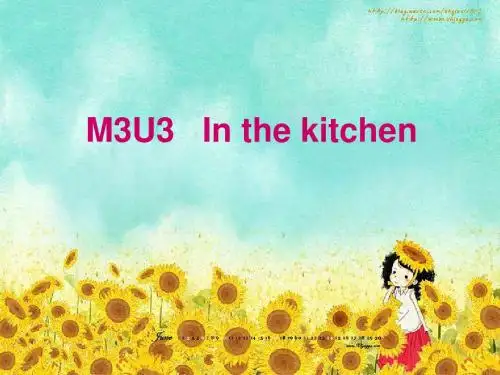
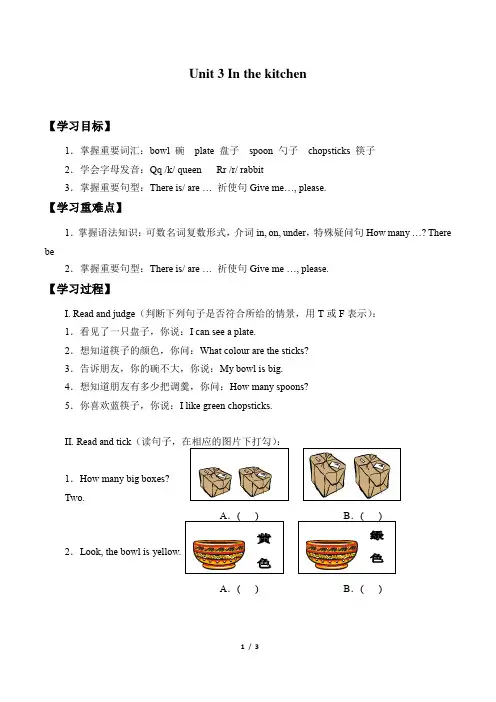
Unit 3 In the kitchen【学习目标】1.掌握重要词汇:bowl 碗plate 盘子spoon 勺子chopsticks 筷子2.学会字母发音:Qq /k/ queen Rr /r/ rabbit3.掌握重要句型:There is/ are … 祈使句Give me…, please.【学习重难点】1.掌握语法知识:可数名词复数形式,介词in, on, under,特殊疑问句How many …? There be2.掌握重要句型:There is/ are … 祈使句Give me …, please.【学习过程】I. Read and judge(判断下列句子是否符合所给的情景,用T或F表示):1.看见了一只盘子,你说:I can see a plate.2.想知道筷子的颜色,你问:What colour are the sticks?3.告诉朋友,你的碗不大,你说:My bowl is big.4.想知道朋友有多少把调羹,你问:How many spoons?5.你喜欢蓝筷子,你说:I like green chopsticks.II. Read and tick(读句子,在相应的图片下打勾):1.How many big boxes?Two.A.( ) B.( ) 2.Look, the bowl is yellow.A.( ) B.( )3.Is the spoon short?No.A.( ) B.( )4.Do you like chopsticks?Yes.A.( ) B.( )5.How many chairs?There is one chair.A.( ) B.( )III. Choose the best answer(选择最佳答案,将字母代号写在前面的括号内):( ) 1.Give ___________ a book, please.A.I B.me C.my( ) 2.How many ___________?A.peach B.peaches C./( ) 3.There __________ one cake.A.is B.am C.are( ) 4.__________ is a queen.A.He B.She C.It( ) 5.The ____________ are small and white(白色的).A.elephants B.tigers C.rabbits( ) 6.Here ____________ are.A.you B.your C.you’re( ) 7.Look at the rabbit. The ears are ___________.A.tall B.long C.short( ) 8.There __________ a big peach.A.am B.is C.are( ) 9.How many ___________?A.queens B.queen C.a queen( ) 10.This is ___________ kitchen.A.I B.I’m C.my( ) 11.Look, the bread is ___________ the plate.A.in B.on C.at( ) 12.Ginger is a ___________.A.cat B.dog C.rabbitIV. Read and choose(读一读,圈出在意义上不属于同一类的单词,圈在字母代号上):1.A.bowl B.blue C.plate2.A.spoon B.room C.chopsticks3.A.is B.are C.can4.A.one B.ten C.on5.A.it B.in C.under。
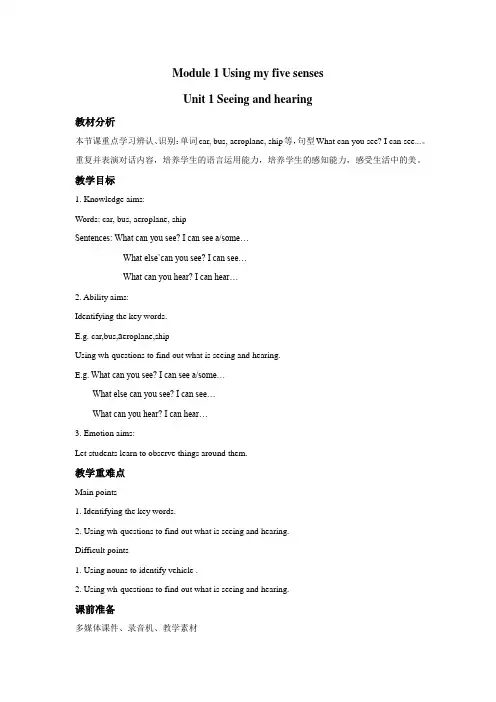
Module 1 Using my five sensesUnit 1 Seeing and hearing教材分析本节课重点学习辨认、识别:单词car, bus, aeroplane, ship等,句型What can you see? I can see...。
重复并表演对话内容,培养学生的语言运用能力,培养学生的感知能力,感受生活中的美。
教学目标1. Knowledge aims:Words: car, bus, aeroplane, shipSentences: What can you see? I can see a/some…What else`can you see? I can see…What can you hear? I can hear…2. Ability aims:Identifying the key words.E.g. car,bus,a eroplane,shipUsing wh-questions to find out what is seeing and hearing.E.g. What can you see? I can see a/some…What else can you see? I can see…What can you hear? I can hear…3. Emotion aims:Let students learn to observe things around them.教学重难点Main points1. Identifying the key words.2. Using wh-questions to find out what is seeing and hearing.Difficult points1. Using nouns to identify vehicle .2. Using wh-questions to find out what is seeing and hearing.课前准备多媒体课件、录音机、教学素材教学过程Step1.Greeting1.Greeting.2.Asking student “Do you know how to use our five senses”. Step2. Presentation1.Learn new words and sentences:1)Look! What can you see?I can see _____________________.There is /are ____________________.2)Listen! What can you hear?I can hear ______.2.DialogueShow some pictures to let students make a dialogue.A:Look, What can you see?B:I can see a ______.A:What else can you see?B:I can see ______.A:What colour can you see?B:I can see a ______.A:What can you hear?B:I can hear a ______.Step3.Practice1.Play a gameMake a spinner1).Draw a circle.2) Cut the circle.3) Colour the circle.4) Use a toothpick.5) Spin the spinner.2.What colour can you see?3.How many children?4.What can the little bird see?It can see ___________.5.Can the ladybird see them?Can the ladybird hear them?6.Listen and enjoy7.按要求改写句子。

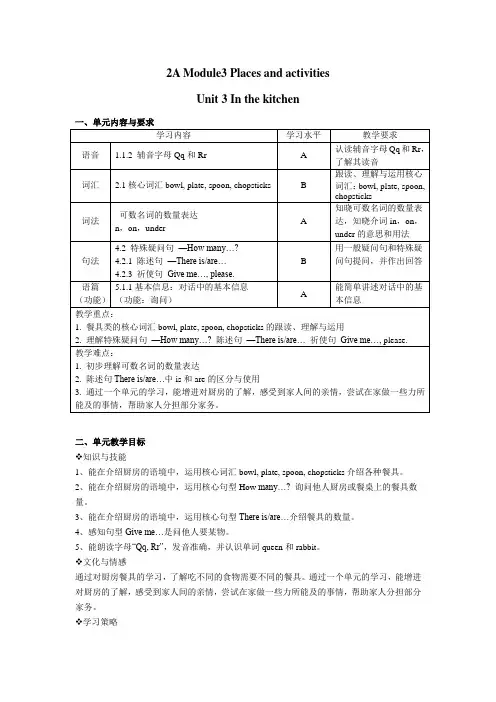
2A Module3 Places and activitiesUnit 3 In the kitchen一、单元内容与要求二、单元教学目标❖知识与技能1、能在介绍厨房的语境中,运用核心词汇bowl, plate, spoon, chopsticks介绍各种餐具。
2、能在介绍厨房的语境中,运用核心句型How many…? 询问他人厨房或餐桌上的餐具数量。
3、能在介绍厨房的语境中,运用核心句型There is/are…介绍餐具的数量。
4、感知句型Give me…是问他人要某物。
5、能朗读字母“Qq, Rr”,发音准确,并认识单词queen和rabbit。
❖文化与情感通过对厨房餐具的学习,了解吃不同的食物需要不同的餐具。
通过一个单元的学习,能增进对厨房的了解,感受到家人间的亲情,尝试在家做一些力所能及的事情,帮助家人分担部分家务。
❖学习策略1.通过听说读的方式,以语篇语境带动核心词句的学习。
2.以师生交流、生生交流的方式初步运用核心词汇和句型。
3.以角色扮演活动、小组交流活动等方法,进一步运用核心词汇和句型。
4.通过表演等方式,综合运用核心词汇和句型,提高语用能力。
【教学重难点】能在In the kitchen的语境中,用简单的句型How many…?询问餐具的数量,并能用There is/are…介绍物品。
做到语音基本准确,表达较为流畅。
四、单课教学目标五、单课文本内容与教学过程Period1 Cook dinner主体学习文本:Alice: What do you need? A spoon?Mother: No, thanks. I need chopsticks.Alice: Here you are.Mother: Thank you. Give me a plate, please.Alice: Here you are.Mother: Noodles are ready. Let’s cook soup.Alice: What do you need? Chopsticks?Mother: No, thanks. I need a big spoon.Alice: Here you are.Mother: Thanks. Give me a bowl, please.Alice: Here you are.Mother: Dinner is ready. Let’s have dinner.Alice: How many bowls?Mother: There are six bowls.预设输出语言:A: What do you need? …?B: No, thanks. I need…A: Here you are.B: Thanks. Give me…, please.A: Here you are.B: …is ready. Let’s…A: How many…?B: There are…Period 2 Naughty Ginger主体学习文本Dinner is ready. There is a table and 5 chairs in the room. There are 6 bowls on the table. There are 9 plates on the table. There are 5 spoons on the table. There is a big birthday cake on the table. Ginger is on the chair. Look! Ginger can jump. The bowl and the spoon are on the floor. Ginger is under the chair.预设输出语言:T here is/are……is/are on the……is/are in the……is/are under the…第二课时教学过程:六、单元评价量表。
上海牛津版3Am1u3展示课教案第一篇:上海牛津版3Am1u3展示课教案Tasting and smellingThe first periodKira Knowledge objectives: to learn the new words e.g.sweet (n)sweet(adj),lemon,sour,salt,salty,coffee,bitter Skill objectives:Using imperatives to give simple introductions e.g.Taste the ing adjectives to describe how the food items smell or taste : e.g.it’s very sour.pre-task warming up say a rhyme: Rough,rough,what is rough? Bag,bag,a bag is rough.Smooth,smooth,what is smooth? Glass,glass ,a glass is smooth.Soft,soft,what is soft ? Bread,bread,a bread is soft.Hard ,hard ,what is hard ? Desk, desk,a desk is hard.review using a story about review the five senses e.g.:My eyes are bright ,my ears are big …My Hands are strong.review the abilities of the five senses.e.g.: My eyes can see and find the sheep.My ears can hear the sheep.…My hands can catch the sheep.have the students introduce themselves using the sentence just like Hui Tailang.While-task 1.Importation The family of Hui Tai lang is siting in the grass.suddenly they hear the sheep.they see the sheep are eating food.so Xiao Hui hui changes very hungry.at the same time ,Xi Yangyang go away.so xiao hui hui and xiao hong hong go and taste.‘sweet’Impo rtation ‘ sweet’.the sweet is covered ,so XiaoHuihui opened it.‘T eaching the word’Listen it.Tweet and sweet find the same letter and fill in theblanks.And spell it.‘teaching sentences’ e.g.: Sweet , sweet Taste the _____.How does it ____? It’s very _____.lemon And a melon for comparison,listen read it and spell e smell say the sentence , e.g.Melon, melon.______,______.Smell the______.Smell the______.How does it _____?How does it _____?It’s very _____.It’s very _____.Use ‘taste ’say the sentence.e.g.: Melon, melon.______,______.Taste the______.Taste the______.How does it ____?How does it ____? It’s very _____.It’s very _____.‘salt’ ‘salty a.Spell and read b.Say the sentence about salt salty e.g.: _____,______.Taste the______.How does it _____?It’s very _____.‘coffee’a..Guessing a riddle about coffeeb..listen and read it office 办公室 c_ _ _ee 咖啡_________,_________________,________ Smell the ________.T aste the ________.How does it ______?How does it ______? It’svery _______.It’svery _____.Post-task Practice 1.say a rhyme RhymeSweet sweet sweet, what is sweet? Sweet sweet sweet, the sweet is sweet Sour sour sour ,what is sour ? Lemon lemon lemon, the lemon is sour.Salty salty salty, what is salty ? Salt salt salt, the salt is salty.Bitter bitter bitter, what is bitterCoffee coffee coffee, the coffee is bitter.2.Go back to the story about Xiao Huihui and Xiao Honghong.fill in the blanks about talking e.g.: Xiao Honghong:_____is very ______.I like it.Xiao Huihui : But Coffee is very _____.Salt is very _____._______ is too sour.T hey are not yummy.Hmm!let’s go.3.do a survey4.teaching the text.Homework 中英翻译1.看见___________2.smell ________3.hear ___________4.尝___________5.甜的___________6.苦的__________7.柔软___________8.rough ________ 9.smooth ________10.坚硬_________二,写出反义词。
2A M3 U3 In the kitchen(Period 1)
一、教学目标和教学重难点
1. 在语境中学习新单词kitchen, bowl, plate, spoon, chopsticks,能读准音。
理解单词含义,简单了解(a) pair of chopsticks的用法。
2. 在创设的情景中学习Yes, please./No, thanks.并能正确使用表达意愿。
3. 能以积极的态度和热情参与儿歌、对话的阅读、表演和创编等各过程,培养学生英语口语表达能力和语用能力。
4. 创设情景、营造轻松的学习氛围,激发学生学习英语的兴趣。
5. 在语境学习中,培养学生在家要帮助父母做事的意识。
教学重点:能介绍厨房中的物品:“bowl, plate, spoon, chopsticks”,了解bowl和plate的不同含义。
难点:学习句型Yes, please./No, thanks.并能正确使用表达意愿。
板书设计:
M3U3 In the kitchen
plate
spoon
bowl
a pair of chopsticks
four pair s of。
2B Module 3 Places and activitiesUnit 3 In the kitchen一、单元教学目标●语言知识与技能1.语音和词汇1)能知道字母Qq, Rr在单词中的发音规则。
(学习内容:1.1.2 辅音字母的读音规则)2)能理解本单元核心词汇bowl, plate, spoon, chopsticks词义,并尝试运用单词进行厨房用具介绍。
(学习内容:2.1核心词汇)2. 句法和语篇(1)能理解并尝试运用句型How many…?There is/are…对物品的数量进行正确询问和应答。
(学习内容:4.2句子种类)(2)能读懂故事,在理解的基础上通过思考和判断,并进行仿说。
(学习内容:5.1.1基本信息)●语言情感在厨房的场景中,引导学生关心身边的人与事,养成帮助家人做力所能及的事的良好生活习惯。
●学习策略1. 能认真倾听、仔细观察、积极思考、在语境中合理想象,主动表达。
2. 能借助板书、媒体视听和任务单,在语境中与同学合作对话和表演。
3. 通过讨论、合作、交流等形式,完成学习任务。
二、单元重点、难点1. 能结合已学语言,讲述故事的基本信息,要求语言较丰富,且具有逻辑性。
2. 能在阅读故事时,从语篇中获取各种不同的信息,并能按照一定的顺序就故事发生的时间、地点、起因、经过、结果进行叙述○1。
三、单元语用任务能在厨房的语境中,借助本单元的核心的语言知识,用至少3句话描述不同的餐具,要求语音正确、内容基本达意,表达较流利。
四、分课时学习内容与要求●语音1. 《上海市小学英语学科教学基本要求》(试验本),P5455,上海教育出版社。
●词汇●词法●句法●语篇五、分课时教学与评价简析六、分课时教学文本及作业第一课时文本Kitty: This is my kitchen.Mum: How many bowls?Kitty: There are four bowls.Mum: How many spoons?Kitty: There is one.Mum: Let’s cook dinner.Kitty: OK. A spoon?Mum: No, thanks.Kitty: Chopsticks?Mum: Yes, please. Give me a plate, please. Kitty: Here you are.Mum: Dinner is ready!Kitty: I’m ing.回家作业及评价1. Look and read2. Listen and enjoyThis is my kitchen.There is a table and a chair in the room. There are two bowls on the table.Ginger is on the chair. Look! Ginger can jump. The bowls are on the floor. Ginger is under the chair. 回家作业及评价1. Listen and enjoy第一课时:八、教学技术与学习资源1. 《义务教育英语课程标准》、《上海市中小学英语课程标准》(征求意见稿)2. 《上海市小学英语学科教学基本要求》(试验本)3. 《上海市小学低年段英语学科基于课程标准评价指南》(试行稿)4. 教材《牛津英语》(上海版)二年级第一学期(试用本)5. 教学板书6. 多媒体课件。
Book: Oxford English 2A M3U3 Theme: In the kitchen Topic: In the kitchen Period: 3课时 话题目标内容方法P1 Bunny 1. 正确跟读字母 Qq, Rr;知晓字母在四线三格 词 汇 :bowl, Listen and answerin the kitchen中的书写位置和笔顺;正确跟读儿歌。
2. 在 语 境 中 正 确 跟 读 核 心 词 汇 : bowl , plate ,spoon,chopsticks 语音语调正确,知晓词义。
3. 知晓核心句型:How many...? There is/are...并在语境中对餐具数量进行模仿问答。
plate,spoon, chopsticks 句型: How many...? There is/are...Listen and follow Look and say Ask and answer Say and actP2 Naughty 1. 正确认读并描摹字母 Qq, Rr,初步了解字母 词 汇 :bowl, Look and writeGinger in the kitchen在单词中的发音,正确朗读儿歌。
2. 在语境中正确认读核心词汇:bowl,plate,spoon,chopsticks 语音语调正确,理解词义。
3. 在语境中尝试运用核心句型:How many...?There is/are...对餐具数量进行询问、应答并在plate,spoon, chopsticks 句型: How many...? There is/are...Listen and answer Look and say Ask and answer Say and act Think and say问答的基础上进行简单描述。
1板书语用任务评价在 图 片 和 老 师 的 尝试对餐具 帮 助 下 , 用 核 心 数量进行模 语 言 询 问 厨 房 餐 仿问答。
Unit 1 Where I livePeriod One Teaching contents: Clean the desk, please.Clean the classroom, please.Teaching aims:1、知识目标:Drill: Clean the ________ , please.2、能力目标:提高学生自然运用英语进行交际的能力。
3、情感目标:教育学生做一个爱卫生讲卫生的好孩子。
Difficult and key points:句型的灵活运用。
Teaching aids: tape, some rags and so onUnit 1 Where I livePeriod TwoTeaching contents: I live in Shanghai.I love Shanghai.Teaching aims:4、 知识目标:Drills: I live in ________ ・ I love ________ .5、能力目标:提高学生实际运用英语的能力。
6、 情感目标:激发学生热爱祖国热爱家乡的美好情感。
Difficult and key points:句型的灵活运用。
Teaching aids: tape, some pictures and so onUnit 1 Where I livePeriod Three Teaching contents: 1. Look and learn2. LettersTeaching aims:7. 知识目标:To learn the new words and letters.& 能力目标:Read the new words and letters properly.9、情感目标:教育学生热爱家园,保持家园安洁。
Difficult and key points: Pronounce words and letters properly. Teaching aids: tape, pictures, word and letter cards Teaching procedure:Unit 1 Where I livePeriod Four Teaching contents: Where do you live?I live in Pudong.I love Pudong.Teaching aims:10、知识目标:Ask and answer: Where do you live? I live in ________ 、11> 能力目标:能自由问答练习12、情感目标:激发学生对祖国对家乡的美好情感Difficult and key points: Where do you live? I live in _______ . Teaching aids: tape, some maps and so onTeaching procedure:Unit 1 Where I livePeriod Five Teaching contents: RhymeTeaching aims:13、知识目标:诵读儿歌并加以表演14、能力目标:能创编儿歌15、情感目标:教育学生做个讲卫生守规范的好孩子Difficult and key points:朗读技能的训练Teaching aids: tape, a toy binTeaching procedure:Unit 2 A snack barPeriod One Teaching contents:Lefs act.Teaching aims:1、知识目标:学会招待客人吃东西的2句简单的祈使句.2、能力目标:会用英语发命令并且根据命令做动作。
M3U3知识点整合+练习知识点整合:1.Words:bowl plate spoon chopsticks2.音标练习:Qq(qu):queen question quiltRr(ir er ur):rabbit rain red bird fern burst3.句型回顾:①A spoon/bowl/plate...? Yes, please./No,thanks.②Give me a plate/bowl..., please. Here you are!③Dinner/Breakfast/Lunch is ready!④How many bowls/plates? There is/are ...⑤There be句型(就近用法):There is a table and two bowls./There are two bowls and a table.⑥under & on: The bowl is on/under the chair.⑦I can skip/jump/run...⑧be doing句型:The Ginger is sitting on/under the chair.⑨fat thin short tall:The rabbit is fat/thin/short/tall.练习:I.正确抄写下列句子,注意大小写和标点符号:Chopsticks? Yes, please.Give me a plate, please. Here you are.II.根据所给内容,写出同类词。
you ________ ________ metheir ________ ________ bowl ________________run ________________ one ________________III.选出不同类的单词。
A. bowlB. spoonC. rubberD. chopsticksA. bookB. deskC. chairD. sofaA. swingB. slideC. seesawD.bedroomA. rabbitB. dogC. netD. pigA. inB. onC. orD. underIV.用所给词的适当形式填空。
2A M3U3 In the kitchen(课时教案)牛津上海版(试用
本)
【Lesson Plan】
Lesson Title: In the Kitchen
Grade Level: 2A
Time: 45 minutes
Objectives:
1. Students will be able to identify different kitchen utensils and appliances.
2. Students will learn how to use adjectives to describe the characteristics of the kitchen utensils and appliances.
3. Students will develop their listening and speaking skills through participating in discussion and role play activities.
Materials:
- Pictures of different kitchen utensils and appliances
- Flashcards with adjectives such as big, small, hot, cold, etc.
- Worksheets with pictures of kitchen utensils and appliances for describing practice
- Role play cards (optional)
Procedure:
1. Warm-up (5 minutes):
Teacher greets the students and asks some warm-up questions such as:
- What do you like to eat for breakfast/lunch/dinner?
- Do you help your parents in the kitchen? What do you do?
2. Presentation (10 minutes):
Teacher shows pictures of different kitchen utensils and appliances, introduces them and explains their functions. Teacher can also use flashcards with adjectives to describe the characteristics of each utensil and appliance.
3. Practice (15 minutes):
Teacher gives students worksheets with pictures of kitchen utensils and appliances for describing practice. Students will choose the appropriate adjectives to describe the characteristics of each utensil and appliance.
4. Listening and Speaking Activity (15 minutes):
Teacher plays an audio clip describing a cooking situation in the kitchen. Students will listen carefully and act out the situation using role play cards or by simply discussing the situation.
5. Wrap-up (5 minutes):
Teacher summarizes the lesson, asks some review questions and invites students to share their thoughts and observations.
Assessment:
- Teacher will assess the students' ability to identify different kitchen utensils and appliances through their participation in class discussions and role play activities.
- Teacher will check the students' worksheets to assess their ability to use adjectives to describe the characteristics of different kitchen utensils and appliances.
Extension:
- Teacher can provide additional worksheets or role
play scenarios for further practice.
- Teacher can bring in real examples of kitchen
utensils and appliances for a hands-on activity where students can touch, feel and explain their functions.。